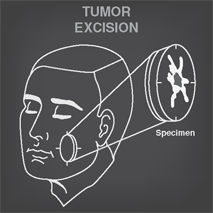Mohs Micrographic Surgery

Mohs micrographic surgery (MMS) is a specialized surgical technique that combines maximal normal tissue preservation with the highest cure rate of any skin cancer treatment. This technique is well suited for periocular cutaneous neoplasms with contiguous growth pattern (i.e., neoplasms with limited metastatic potential). The micrographic (Mohs) surgeon and ophthalmic plastic surgeon (OPS) can combine their skills so that patients can benefit from both specialties. Through this division of labor, the micrographic surgeon can concentrate exclusively on accurate tumor extirpation, and the OPS can concentrate on restoring function and cosmesis through reconstruction of the resulting defect.
INDICATIONS
Patients may be referred to micrographic surgeons for a variety of lesions. Although basal cell carcinoma (BCC) represents approximately 90% of malignant tumors of the eyelids, other primary eyelid tumors include squamous cell carcinoma (SCC); carcinoma in situ (CIS or Bowen’s disease); keratoacanthoma (KA); sebaceous carcinoma; malignant melanoma; and tumors of eccrine, apocrine, or accessory lacrimal gland origin.
In general, any eyelid tumor that can be reliably interpreted by frozen sections and that demonstrates contiguous growth patterns can be treated by MMS. Mohs micrographic excision followed by oculoplastic repair is a widely accepted method of treatment for periocular BCC, SCC, CIS, and KA. Sweat gland carcinoma, although rare, can generally be interpreted by frozen-section histopathologic methods and, therefore, is also amenable to MMS. Sebaceous carcinoma and malignant melanoma, because of their noncontiguous growth features, metastatic potential, and difficulty of interpretation by frozen sections, present some controversy concerning their suitability for MMS. BCC and SCC may be classified on their clinical or histologic appearance. On the basis of biologic behavior, morpheaform BCC and poorly differentiated SCC are notorious for their extensive microscopic spread, well beyond the clinically apparent margin. BCC is much more common on the lower eyelid, but both tumors can be seen on either the upper or the lower lid. Sebaceous carcinoma presents special problems because of its multifocal growth pattern, rendering any method of excision with margin control difficult. It may also demonstrate pagetoid spread, a histologic change that can be difficult to identify, even on permanent sections.
Patients are usually seen for preoperative evaluation by both the MMS and OPS team. Biopsy, if not already performed by a referring physician, can be done by either the MMS or the OPS. Relevant history and physical examination is done and preoperative laboratory studies are obtained. Once the tumor histopathology is confirmed, the nature of the tumor and the technique of MMS as well as reconstructive options are discussed in detail with the patient. It is important for the patient to understand that the size of surgical defect cannot be accurately predicted, and that is why the surgery is done with microscopic control. Therefore, the OPS will be able to discuss general reconstructive considerations, not precise details. In most centers, MMS and reconstruction by the OPS are scheduled on separate days. In less extensive tumor cases, MMS and OPS reconstruction may be completed in 1 day; however, it is best for patients to plan for a 2-day procedure.
PROCEDURE
The clinically evident tumor is debulked, if necessary, with a curette, scalpel, or a fine tissue scissors. Frequently, the grossly evident tumor is small, and debulking is not necessary. In such cases, or after all the apparent tumor is debulked, a 1- to 43-mm margin (depending on cell type, duration, size, and whether it is primary or recurrent tumor) is marked circumferentially around the clinically apparent tumor or the initial defect. With the scalpel at a 45° angle beveling toward the base of the wound, rather than perpendicular, a shallow incision is made along the mark. From the beveled incision, a saucer-shaped, 1 to 43-mm–thick specimen is carefully excised. The orientation is preserved, and the specimen is placed on moistened gauze (which is also marked to maintain orientation). Hemostasis is achieved with bipolar electrocoagulation, and a dressing is applied.
Stay updated, free articles. Join our Telegram channel

Full access? Get Clinical Tree


